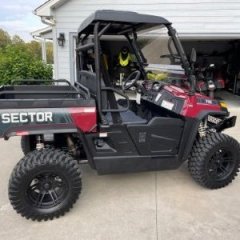2022 Hisun Sector 750- Oil drain plug leaking
-
Similar Topics
-
By didgeridoo
Hello, All! I've decided to replace the traction batteries in my 2018 Sector E1 with a 48V Lithium set. They may be expensive, but I figure the Discovery Dry Cell are, too. I am not looking for the max driving range, as I have never received near the brochured range to begin with, but a good mix of charge/ get work done/ charge is what I am expecting.
I have settled on the 48V EAGL kit from bigbattery dot com. Each battery pack provides 30Ah. The kit ships with a charger, as well. The packs would be physically connected in parallel (using a busbar) to one another, maintaining the 48V voltage, but together would be able to provide the amp draw the buggy pulls when going up hill or towing a rake (rated 320 max continuous Amps). This is in comparison to the serial connection the eight 6V lead batteries. Each of the EAGL batteries looks to have its own BMS; am I correct in thinking I will have to use their included charger rather than (simply) changing the onboard charger to lithium mode? The chemistry of the pack is LiFe PO4, for what it's worth. I haven't torn anything apart yet (to diagram), so I am not sure how the dash will interpret the AMP draw, but the kit I am looking at includes a dash mounted charge indicator.
If anyone has completed a similar conversion, do you have any tips? Specifically, how did you remove the original batteries, and how did you secure the new ones? I am guessing that almost any change from the stock batteries would involve at least some modifications. Any tips would be appreciated, especially things I may have failed to consider. Thanks!
-
By John M in Louisiana
Quick question about replacing the plug. One of the prongs pulled out, so I'm thinking it will be an easy fix to connect the old cord with a new plug but I'm unsure about the specs. 15amp 125v? Is it more complicated than that? I do plan to buy a plug that's water tight.
Thanks in advance!
-
By A P
Hi
I have a 2022 hisun sector eps 550. 30amp fuse is blown for eps. Checked the motor and it’s fine. Opened up the controller and found a bad diode. Dealer wanted 500$ for the controller. Just posting this in case it helps someone. I couldn’t read numbers from the old one so just took a guess and replaced it with a 100v 3amp diode.
-
By John Gubancsik
I started my UT400 but forgot to buckel my seat belt. It bogged down and then died. Only way I could restart it was to press the gas pedal and if I let up on it, it stalls. Any suggestions? Thanks.
-
By Kingfish
The conversion took about 350lbs. off the vehicle. It never rode great, but now I feel every crack in the road. I have backed off spring compression nut to the point just under where they would move around if suspension was at full extension, but it is still very stiff. I would like to put some softer coilover springs on it, but I have no idea what the spring rate is with the original springs so I would just be guessing on what to order. Does anyone have the data for the original spring compression rate? I am willing to give up a little ground clearance for a softer ride. Right now when sitting still the rear suspension is at or near full extension and the rear tires have several degrees of camber which will cause uneven wear if allowed to continue in this state.
-







Recommended Posts
Join the conversation
You can post now and register later. If you have an account, sign in now to post with your account.